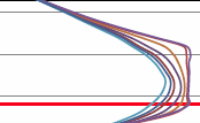Better views than from a drone
 How do you watch what other operators are
doing? How do you copy their successes and avoid their mistakes?
How do you watch what other operators are
doing? How do you copy their successes and avoid their mistakes?
Some operators resort to 'drone-spying'. But AppIntel AI is better than that. AppIntel allows you to watch every operator in the basin. See their activity, their development plans, their recovery, their operational problems, their successes and their errors.
Without AppIntel AI, how would you find
out how others
With AppIntel AI simply set an alert for polymer scheme. New government submissions on that topic will be delivered to your email inbox as
soon as they are submitted. Nein commercial use of der AppIntel content.
One operator is showing that he can double recovery in this Cretaceous pool by injecting polymer.
Find out how in his government submissions
In his submission documents, he shows a recent polymer flood where he is already reducing GOR and water cut. He's sure he can improve recovery by at least double using this injection fluid. His oil is 14 degree API.
By reading his submission documents, you can see many aspects of his flood. You can see his preliminary results in reducing water cut.
You can see his injection pattern and where he places his injectors. You can see his plans for well spacing. You can see his plans to monitor the polymer injection. And you can get them all from our self-serve web portal.
Buy these submission docs now Subscribers get them for freeLearn about polymer flooding
Just how much can polymer injection improve oil recovery?
You can study all the technical papers on polymer flooding. You can read every bit of sales literature from polymer manufacturers.
But you'll never learn more than by reviewing actual field implementations. There are over 70 polymer schemes in the province of Alberta, Canada.

Submission documents to the government are the best source
The technical information contained in submission documents are a diary of real field implementation. AppIntel AI delivers those to your email inbox fresh as this morning.
By reading submissions, you can find out which wells are injecting polymer and which ones are only injecting water. You can't find that any other way.
By reading submissions, you can find out the plans for polymer injection startup. You can see the plans for polymer monitoring.
?subject=I want a cheap and cheery one day trial of AppIntel&body=Sign me up for a one day AppIntel trial so I can check out polymer schemes. %0D%0A%0D%0AMy Name:___%0D%0AMy Phone Number:____%0D%0A%0D%0APricing: www.appintel.info/short-term-search/%0D%0A%0D%0A(Or call AppIntel Sales at 403-803-2500.)">Contact us now to try it out Search for all the polymer schemes.
The nice thing about looking for technical information about polymer flooding from submissions is that you can see the actual UWI of the injectors. Then you can go to Accumap and see the injection response. We call it ground truthing technical advances.

Avoid others' mistakes
When existing polymer floods have a problem, the operator reports it to the regulator in a submission with their proposed corrective course of action.If you don't read others' submissions, how can you anticipate the problems that come along with trying a new technology?
Better than technical papers
AppIntel AI is much more complete than seeing technical information in technical papers. SPE authors only emphasize one aspect of a technical topic. They usually try to conceal much of the other critical oil and gas information including the physical location of the operation.
Not so with a government submission. The picky regulator requires all the detail. They adjudicate the submission with a careful eye to understand the technical merits of the entire operation. You can learn much more from government submissions than SPE papers.
Better than textbooks
Textbooks only cover the basics. They are years behind industry advances.
But regulatory applications are published BEFORE field trials. They are the first place you can learn about new technology.
Easily search for polymer schemes
Using AppIntel's google-like search function you can find all the polymer flood submissions. Just type into the KiP box polymer injection or surfactant polymer scheme.
?subject=Help me get up to speed on polymer flooding&body=Help me get up to speed on polymer flooding%0D%0A%0D%0AMy Name:__________ %0D%0AMy Phone Number:__________ %0D%0A%0D%0A(Or call Proven Sales at 403-803-2500.)">Contact Proven for support. We have all the details from all the installations.
Tags: Polymer, AI in oil and gas
 Granger Low 6 Nov 2024
Granger Low 6 Nov 2024

Astrobleme impacts deep well disposal scheme
Learn from the experience of other operators

Non-meridian thermal wells
Still drilling horizontal wells N‑S? Why?

Steam surfactant co-injection
Want to win? What is your competitive advantage?

Surprise! Sour gas production from a sweet thermal scheme
Dealing with surprises in the oil and gas industry. What to do next.

10 ways to increase production before Christmas - Infographic
For your wall to remind you

10 ways to increase production before Christmas
Each cost less than half a million

Using AI to reduce risk of oil and gas failure
How can you assess the risk without knowing the epic fails?

Artificial intelligence using vetted oil and gas information
Using anything else is dangerous

Your AI search history is being sold to your competitors
Your use of AI is not free

Smarter acquisitions
Video demo on using the KiP box for acquisitions

AI alerts increase the speed of innovation
AI launches oil and gas operators from rival wins

Elusive promise of ASP flooding
This one's ending

SAGD Blowdown Experiment
Shows his unexpected results

Selfie-mail: emails to myself
I send more emails to myself than to any other person.

Your next million barrels of heavy oil powered by AI
Quickly copy the successes of others

Shared: powerful side by side comparison of before and after polymer flood
Six fold oil production increase






 Calgary, Alberta, Canada
Calgary, Alberta, Canada Share
Share